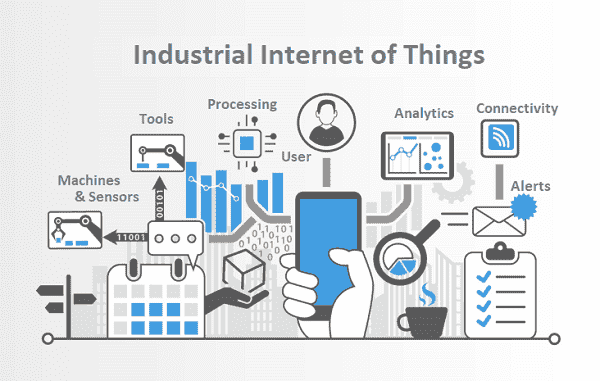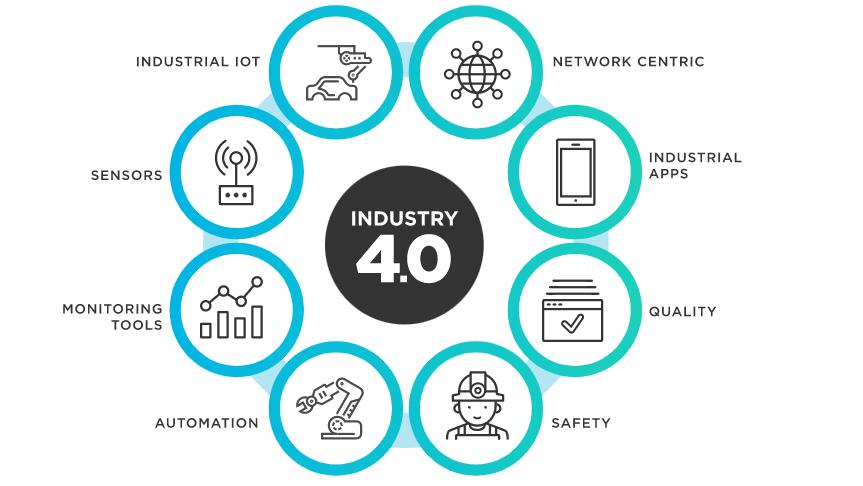
Industrial Internet of Things (IIoT)
What is the industrial internet of things (IIoT)?
The industrial internet of things (IIoT) refers to the extension and use of the internet of things (IoT) in industrial sectors and applications. With a strong focus on machine-to-machine (M2M) communication, big data, and machine learning, the IIoT enables industries and enterprises to have better efficiency and reliability in their operations. The IIoT encompasses industrial applications, including robotics, medical devices, and software-defined production processes.
The IIoT goes beyond the normal consumer devices and internetworking of physical devices usually associated with the IoT. What makes it distinct is the intersection of information technology (IT) and operational technology (OT). OT refers to the networking of operational processes and industrial control systems (ICSs), including human machine interfaces (HMIs), supervisory control and data acquisition (SCADA) systems, distributed control systems (DCSs), and programmable logic controllers (PLCs).
The convergence of IT and OT provides industries with greater system integration in terms of automation and optimization, as well as better visibility of the supply chain and logistics. The monitoring and control of physical infrastructures in industrial operations, such as in agriculture, healthcare, manufacturing, transportation, and utilities, are made easier through the use of smart sensors and actuators as well as remote access and control.
In the context of the fourth industrial revolution, dubbed Industry 4.0, the IIoT is integral to how cyber-physical systems and production processes are set to transform with the help of big data and analytics. Real-time data from sensors and other information sources helps industrial devices and infrastructures in their “decision-making,” in coming up with insights and specific actions. Machines are further enabled to take on and automate tasks that previous industrial revolutions could not handle. In a broader context, the IIoT is crucial to use cases related to connected ecosystems or environments, such as how cities become smart cities and factories become smart factories.
The consistent capturing and transmitting of data among smart devices and machines provide industries and enterprises with many growth opportunities. The data allows industries and enterprises to pick up on errors or inefficiencies in the supply chain, for example, and immediately address them, thus pushing for day-to-day efficiency in operations and finance. Proper integration of the IIoT can also optimize the use of assets, predict points of failure, and even trigger maintenance processes autonomously.
By adopting connected and smart devices, businesses are enabled to gather and analyze greater amounts of data at greater speeds. Not only will this enhance scalability and performance, but it can also bridge the gap between the production floors and general offices. Integration of the IIoT can give industrial entities a more accurate view of how their operations are moving along and help them make informed business decisions.

What are the security considerations and challenges in adopting the IIoT?
Adoption of the IIoT can revolutionize how industries operate, but there is the challenge of having strategies in place to boost digital transformation efforts while maintaining security amid increased connectivity.
Industries and enterprises that handle operational technologies can be expected to be well-versed in such aspects as worker safety and product quality. However, given that OT is being integrated into the internet, organizations are seeing the introduction of more intelligent and automated machines at work, which in turn invites a slew of new challenges that would require understanding of the IIoT’s inner workings.
With IIoT implementations, three areas need to be focused on: availability, scalability, and security. Availability and scalability may already be second nature to industrial operations, since they could already have been established or in the business for quite some time. Security, however, is where many can stumble when integrating the IIoT into their operations. For one thing, many businesses still use legacy systems and processes. Many of these have been in operation for decades and thus remain unaltered, thereby complicating the adoption of new technologies.
Also, the proliferation of smart devices has given rise to security vulnerabilities and the concern of security accountability. IIoT adopters have the de facto responsibility of securing the setup and use of their connected devices, but device manufacturers have the obligation of protecting their consumers when they roll out their products. Manufacturers should be able to ensure the security of the users and provide preventive measures or remediation when security issues arise.
Even more, the need for cybersecurity is brought to the fore as more significant security incidents surface over the years. Hackers gaining access to connected systems do not only mean exposing the business to a major breach, but also mean potentially subjecting operations to a shutdown. To a certain extent, industries and enterprises adopting the IIoT have to plan and operate like technology companies in order to manage both physical and digital components securely.

Adopters are also faced with the challenge of properly integrating industrial operations with IT, where both connection and information need to be secured. Users’ data should be processed in accordance with applicable privacy regulations, such as the European Union (EU) General Data Protection Regulation (GDPR). While gathered data plays an important role in generating insights for the devices and infrastructures, it is imperative that personal information be segregated from general log data. Information like personally identifiable information (PII) should be stored in an encrypted database. Storing unencrypted information together with other relevant activity in the cloud could mean businesses running the risk of exposure.
One of the major concerns that have been surrounding the IoT is technology fragmentation, and the IIoT, by extension, isn’t exempt from the coexistence of different standards, protocols, and architectures. The varying use in IIoT systems, for example, of standards and protocols such as Message Queuing Telemetry Transport (MQTT) and Constrained Application Protocol (CoAP) may hinder IIoT systems’ interoperability.
What is the industrial internet of things (IIoT)?
The industrial internet of things (IIoT) refers to the extension and use of the internet of things (IoT) in industrial sectors and applications. With a strong focus on machine-to-machine (M2M) communication, big data, and machine learning, the IIoT enables industries and enterprises to have better efficiency and reliability in their operations. The IIoT encompasses industrial applications, including robotics, medical devices, and software-defined production processes.
The IIoT goes beyond the normal consumer devices and internetworking of physical devices usually associated with the IoT. What makes it distinct is the intersection of information technology (IT) and operational technology (OT). OT refers to the networking of operational processes and industrial control systems (ICSs), including human machine interfaces (HMIs), supervisory control and data acquisition (SCADA) systems, distributed control systems (DCSs), and programmable logic controllers (PLCs).
The convergence of IT and OT provides industries with greater system integration in terms of automation and optimization, as well as better visibility of the supply chain and logistics. The monitoring and control of physical infrastructures in industrial operations, such as in agriculture, healthcare, manufacturing, transportation, and utilities, are made easier through the use of smart sensors and actuators as well as remote access and control.
In the context of the fourth industrial revolution, dubbed Industry 4.0, the IIoT is integral to how cyber-physical systems and production processes are set to transform with the help of big data and analytics. Real-time data from sensors and other information sources helps industrial devices and infrastructures in their “decision-making,” in coming up with insights and specific actions. Machines are further enabled to take on and automate tasks that previous industrial revolutions could not handle. In a broader context, the IIoT is crucial to use cases related to connected ecosystems or environments, such as how cities become smart cities and factories become smart factories.
The consistent capturing and transmitting of data among smart devices and machines provide industries and enterprises with many growth opportunities. The data allows industries and enterprises to pick up on errors or inefficiencies in the supply chain, for example, and immediately address them, thus pushing for day-to-day efficiency in operations and finance. Proper integration of the IIoT can also optimize the use of assets, predict points of failure, and even trigger maintenance processes autonomously.
By adopting connected and smart devices, businesses are enabled to gather and analyze greater amounts of data at greater speeds. Not only will this enhance scalability and performance, but it can also bridge the gap between the production floors and general offices. Integration of the IIoT can give industrial entities a more accurate view of how their operations are moving along and help them make informed business decisions.

What are the security considerations and challenges in adopting the IIoT?
Adoption of the IIoT can revolutionize how industries operate, but there is the challenge of having strategies in place to boost digital transformation efforts while maintaining security amid increased connectivity.
Industries and enterprises that handle operational technologies can be expected to be well-versed in such aspects as worker safety and product quality. However, given that OT is being integrated into the internet, organizations are seeing the introduction of more intelligent and automated machines at work, which in turn invites a slew of new challenges that would require understanding of the IIoT’s inner workings.
With IIoT implementations, three areas need to be focused on: availability, scalability, and security. Availability and scalability may already be second nature to industrial operations, since they could already have been established or in the business for quite some time. Security, however, is where many can stumble when integrating the IIoT into their operations. For one thing, many businesses still use legacy systems and processes. Many of these have been in operation for decades and thus remain unaltered, thereby complicating the adoption of new technologies.
Also, the proliferation of smart devices has given rise to security vulnerabilities and the concern of security accountability. IIoT adopters have the de facto responsibility of securing the setup and use of their connected devices, but device manufacturers have the obligation of protecting their consumers when they roll out their products. Manufacturers should be able to ensure the security of the users and provide preventive measures or remediation when security issues arise.
Even more, the need for cybersecurity is brought to the fore as more significant security incidents surface over the years. Hackers gaining access to connected systems do not only mean exposing the business to a major breach, but also mean potentially subjecting operations to a shutdown. To a certain extent, industries and enterprises adopting the IIoT have to plan and operate like technology companies in order to manage both physical and digital components securely.

Adopters are also faced with the challenge of properly integrating industrial operations with IT, where both connection and information need to be secured. Users’ data should be processed in accordance with applicable privacy regulations, such as the European Union (EU) General Data Protection Regulation (GDPR). While gathered data plays an important role in generating insights for the devices and infrastructures, it is imperative that personal information be segregated from general log data. Information like personally identifiable information (PII) should be stored in an encrypted database. Storing unencrypted information together with other relevant activity in the cloud could mean businesses running the risk of exposure.
One of the major concerns that have been surrounding the IoT is technology fragmentation, and the IIoT, by extension, isn’t exempt from the coexistence of different standards, protocols, and architectures. The varying use in IIoT systems, for example, of standards and protocols such as Message Queuing Telemetry Transport (MQTT) and Constrained Application Protocol (CoAP) may hinder IIoT systems’ interoperability.




